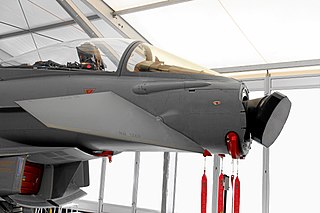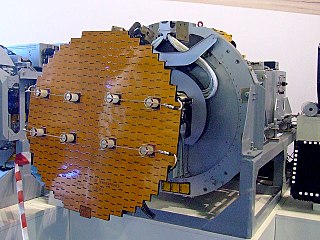
Radar is a system that uses radio waves to determine the distance (ranging), direction, and radial velocity of objects relative to the site. It is a radiodetermination method used to detect and track aircraft, ships, spacecraft, guided missiles, motor vehicles, map weather formations, and terrain.

An active electronically scanned array (AESA) is a type of phased array antenna, which is a computer-controlled antenna array in which the beam of radio waves can be electronically steered to point in different directions without moving the antenna. In the AESA, each antenna element is connected to a small solid-state transmit/receive module (TRM) under the control of a computer, which performs the functions of a transmitter and/or receiver for the antenna. This contrasts with a passive electronically scanned array (PESA), in which all the antenna elements are connected to a single transmitter and/or receiver through phase shifters under the control of the computer. AESA's main use is in radar, and these are known as active phased array radar (APAR).

A pulse-Doppler radar is a radar system that determines the range to a target using pulse-timing techniques, and uses the Doppler effect of the returned signal to determine the target object's velocity. It combines the features of pulse radars and continuous-wave radars, which were formerly separate due to the complexity of the electronics.

Rajendra is a passive electronically scanned array radar developed by the Defence Research and Development Organisation (DRDO). This acts as the Fire-control radar for Akash weapon system. It is a multifunction radar, capable of surveillance, tracking and engaging low radar cross section targets. It is a ground surveillance radar and is a great source of surveillance operating at frequency around 20 GHz. It is mainly used to track enemy's installations.

The AN/MPQ-64 Sentinel is an X-band electronically steered pulse-Doppler 3D radar system used to alert and cue Short Range Air Defense (SHORAD) weapons to the locations of hostile targets approaching their front line forces. It is currently produced by Raytheon Missiles & Defense.

The Erieye radar system is an Airborne Early Warning and Control System (AEW&C) developed by Saab Electronic Defence Systems, formerly Ericsson Microwave Systems, of Sweden. It uses active electronically scanned array (AESA) technology. The Erieye is used on a variety of aircraft platforms, such as the Saab 340 and Embraer R-99. It has recently been implemented on the Bombardier Global 6000 aircraft as the GlobalEye.
Bharat Electronics Limited (BEL) is an Indian public sector aerospace and defence electronics company. It primarily manufactures advanced electronic products for ground and aerospace applications. BEL is one of sixteen PSUs under the administration of Ministry of Defence of India. It has been granted Navratna status by the Government of India.
Man-portable radar is a lightweight surveillance radar system that does not require vehicle support to transport or operate. Man-portable radars were developed to introduce radar to remote areas where vehicle support is not feasible.
The PS-05/A is a pulse-doppler radar currently used by the JAS 39 Gripen fighter aircraft. It weighs 156 kg and was developed by Ericsson in collaboration with GEC-Marconi, sharing some technology with the latter's Blue Vixen radar for the Sea Harrier.
The Airborne Surveillance Platform (ASP) is an Indian defence project initiated by the Defence Research and Development Organisation (DRDO) with the aim to produce an Airborne Early Warning System. Two prototypes were developed and flight tested for three years. The project was cancelled in 1999 after the prototype aircraft crashed, killing eight scientists and the aircrew. After four years of inactivity, the project was revived in 2004 with a new platform and radar.

The Swathi weapon locating radar is a mobile artillery-locating, phased array radar developed by India. This counter-battery radar is designed to detect and track incoming artillery and rocket fire to determine the point of origin for counter-battery fire.
Electronics and Radar Development Establishment (LRDE) is a laboratory of the Defence Research & Development Organisation (DRDO), India. Located in C.V. Raman Nagar, Bengaluru, Karnataka, its primary function is research and development of radars and related technologies. It was founded by S. P. Chakravarti, the father of Electronics and Telecommunication engineering in India, who also founded DLRL and DRDL.

The central acquisition radar (3D-CAR) is a 3D radar developed by the Defence Research and Development Organisation (DRDO) for use with Akash Surface-to-air missiles and is capable of tracking 150 targets.

The DRDO Airborne Early Warning and Control System (AEW&CS) is a project of India's Defence Research and Development Organisation to develop an airborne early warning and control system for the Indian Air Force. It is also referred to as NETRA Airborne Early Warning and Control System (AEW&CS).

The PJT-531 Battle Field Surveillance Radar – Short Range(BFSR-SR) is a man portable 2D short-range battlefield and perimeter surveillance radar developed by the Indian Defence Research and Development Organisation (DRDO). The BFSR has been designed by DRDO's Bengaluru-based laboratory, the Electronics and Radar Development Establishment (LRDE) and is being manufactured by Bharat Electronics Limited (BEL).

Quick Reaction Surface-to-Air Missile (QRSAM) is a missile developed by the Defence Research and Development Organisation (DRDO), Bharat Electronics and Bharat Dynamics Limited for the Indian Army, meant for protecting moving armoured columns from aerial attacks.

Uttam is a solid-state gallium arsenide (GaAs) based active electronically scanned array (AESA) radar under development by the Electronics and Radar Development Establishment (LRDE), a laboratory of the Indian Defence Research and Development Organisation (DRDO). It is a low probability of intercept radar. It is a liquid cooled AESA radar featuring quad band modules that can be stacked to form a larger unit. This allows the manufacturer to scale the radar to be used in larger aircraft.
This article consists of projects of the Defence Research and Development Organisation.












